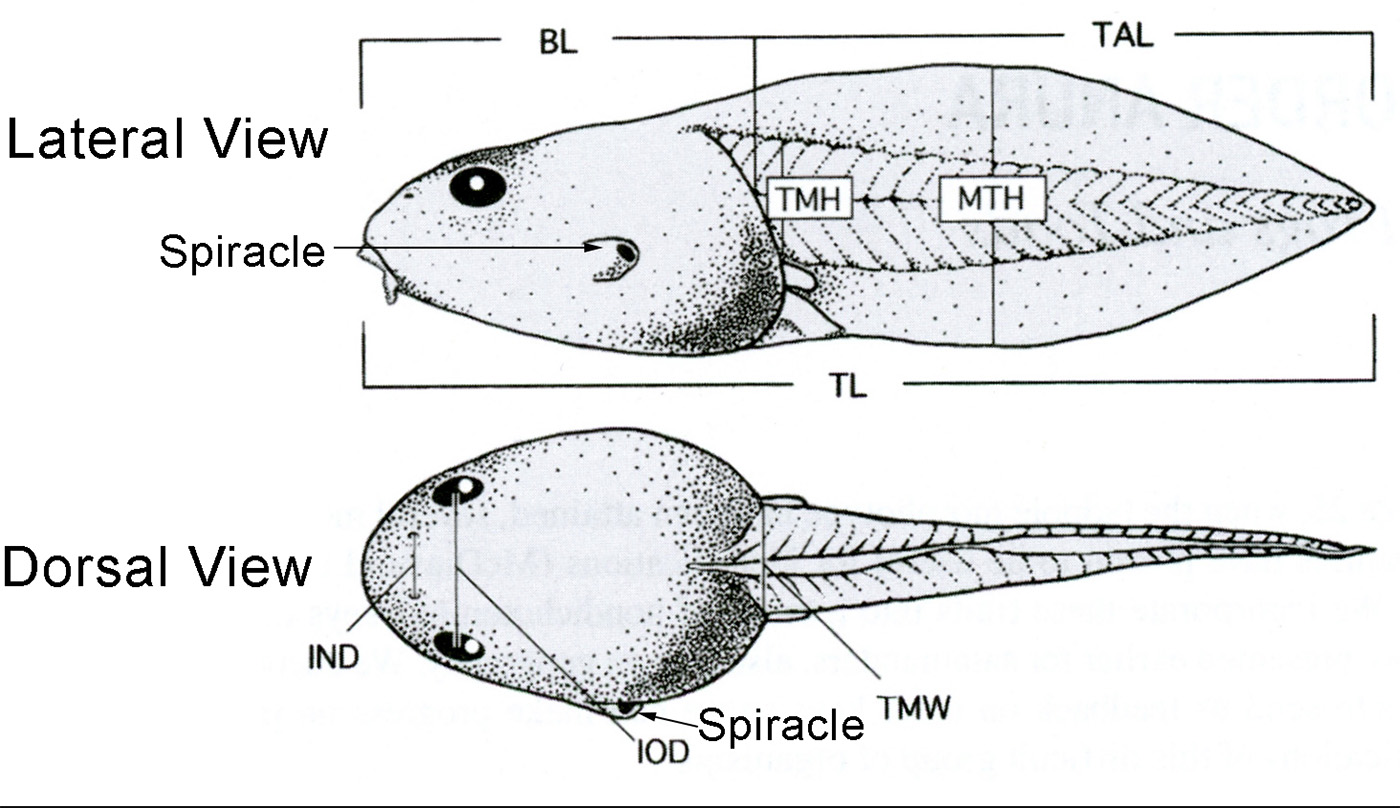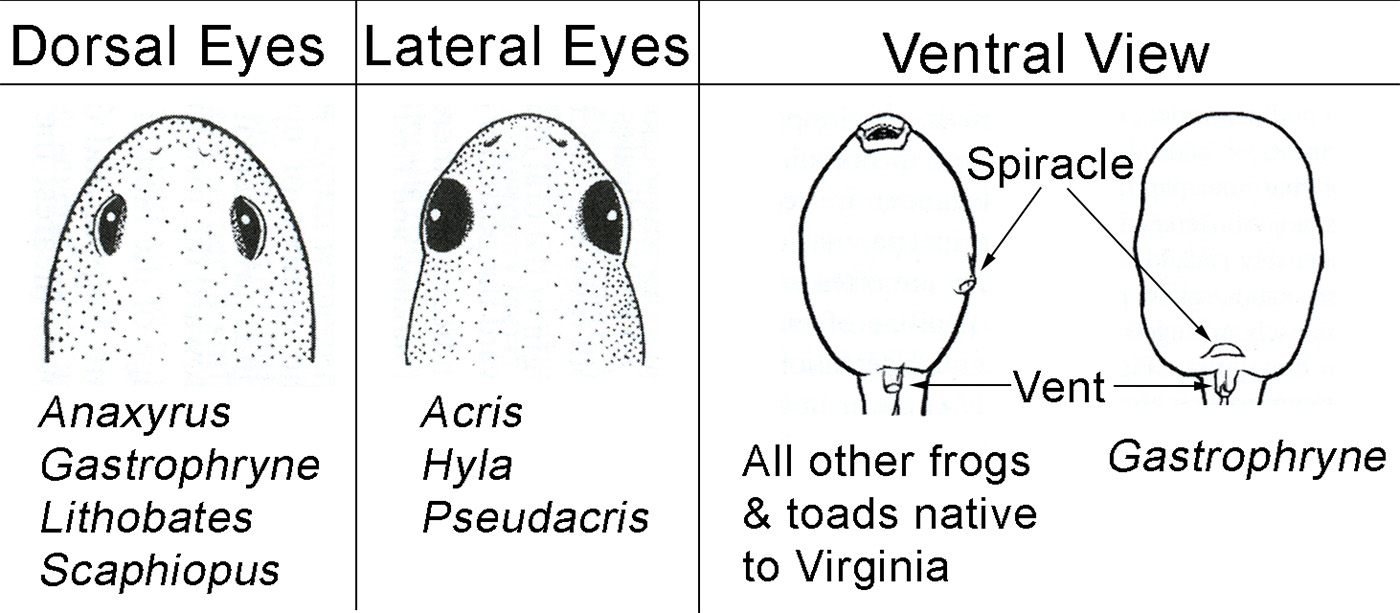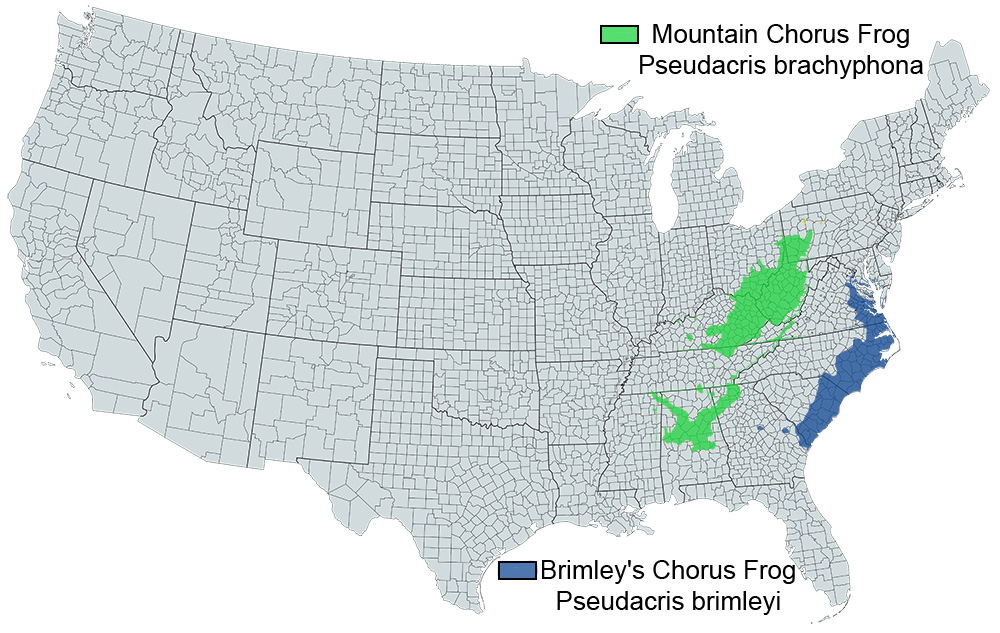Mountain Chorus Frog
Pseudacris brachyphona
Common Name: |
Mountain Chorus Frog |
Scientific Name: |
Pseudacris brachyphona |
Etymology: |
|
Genus: |
Pseudacris is derived from the Greek words pseudes meaning "false" and akris meaning "locust". |
Species: |
brachyphona is derived from the Greek words brachys which means "short" and phone which means "voice". This refers to the short call of this frog. |
Average Length: |
1 - 1.3 in. (2.5 - 3.2 cm) |
Virginia Record Length: |
|
Record length: |
1.5 in. (3.8 cm) |
Virginia Wildlife Action Plan Rating Tier II - Very High Conservation Need has a high risk of extinction or extirpation. Populations of these species are at very low levels, facing real threat(s), or occur within a very limited distribution. Immediate management is needed for stabilization and recovery.
Physical Description - This species has dorsal pattern resembling reversed parentheses which may touch at the middorsum to form a X- or H-shaped pattern. The dorsal background color is gray to olive. Ventral surfaces are whitish; males have dark throats. There is a yellow pigment on concealed and lower surfaces of legs. There is typically a white line on the upper lip and a dark triangle between the eyes. This species is different from other chorus frogs in that it has a stockier body, wide head, large digital pads, and no middorsal strip or spots.
Historical versus Current Distribution - The historical range of Mountain Chorus Frogs (Pseudacris brachyphona) was undoubtedly wider than is currently known due to the occurrence of disjunct populations in several states (Hoffman, 1980). Current distribution is primarily in the Appalachian Plateau Physiographic Province from central western Pennsylvania southwestward through the Appalachians to southwestern Georgia, central Alabama, and northeastern Mississippi (Hoffman, 1980).
Historical versus Current Abundance - Green (1952) estimated 1,069–1,815 individuals in ten pools over a 4-yr period in West Virginia. McClure (1996) examined three of Green's pools in 1993 (the other sites had been destroyed) and estimated population sizes of 6–116.
Life History Features - The life history and ecology of Mountain Chorus Frogs has been summarized by Green (1938, 1964), Wright and Wright (1949), Barbour (1957, 1971), and Green and Pauley (1987).
Breeding - Reproduction is aquatic.
Breeding migrations - Green (1952) observed mass movements of breeding Frogs at the beginning of the breeding season. Initiation of the calling period depends on temperature, but usually begins in late February to early March after males emerge from terrestrial hibernacula (Green, 1964). Males call from the edges of pools and do not conceal themselves as do most other species in this genus. Calling periods are sporadic in winter, occurring during warm spells in January. Breeding activity occurs late February to early June in West Virginia (Green, 1964) and mid February to May in Kentucky (Barbour, 1971). Males will also call periodically throughout the summer, returning to breeding sites after each rainfall (Green and Pauley, 1987).
Breeding habitat - Mountain Chorus Frogs breed in shallow wetlands at elevations from about 365–1,341 m (Green, 1938; Hoffman, 1981; Pauley, 1993a). Habitats include temporary pools, roadside ditches, pools in roadruts, mountaintop bogs, furrows in plowed fields, seepages, and woodland springs.
Egg deposition sites - Females arrive at breeding sites after males, select a mate, and lay eggs attached to vegetation in several eggs masses containing 10–50 eggs or on the bottom of the pool unattached to vegetation. More have been laid unattached than attached (T.K.P., unpublished data).
Clutch size - Total clutch size is 300–1,500 (Green, 1938; Barbour, 1971). Dates of egg laying are 20 March–2 July (Green, 1938). Hoffman (1955, 1981) found egg masses in southwestern Virginia on 30 March and 1 July. Barbour (1971) found egg masses at a high elevation site in August. Females leave breeding sites the same night of egg laying (Green, 1964)
Larvae/Metamorphosis - Eggs hatch in about 7–10 d; the larval period is short, lasting about 30–64 d, depending on temperature (Green, 1938; Barbour, 1971). Newly metamorphosed animals were found on 2 June in West Virginia, and size at metamorphosis was 11–13 mm SVL (Green, 1964; Green and Pauley, 1987).
Tadpoles:

| Lateral View | Dorsal View |
|---|---|
| BL = Body Length | IND = Internarial Distance |
| MTH = Maximum Tail Height | IOD = Interorbital Distance |
| TAL = Tail Length | TMW = Tail Muscle Width |
| TL = Total Length | |
| TMH = Tail Muscle Height |

Juvenile Habitat - Similar to adult habitats.
Adult Habitat - Green (1952) determined that Mountain Chorus Frogs move downhill to breeding pools. He found that males move between pools during the breeding season. Maximum distance traveled was 610 m within the same season, and 1,219 m between breeding seasons. Mountain Chorus Frogs presumably move upslope after the breeding season to forage and seek shelter in surrounding terrestrial habitats.
Home Range Size - Unknown.
Territories - Unknown.
Aestivation/Avoiding Dessication - Unknown.
Seasonal Migrations - Mountain Chorus Frogs migrate from breeding sites to foraging sites and shelters on hillsides in the forest after the breeding season.
Torpor (Hibernation) - Overwintering sites are underground (Green, 1964).
Interspecific Associations/Exclusions - Brimley's Chorus Frogs are sympatric with American Toads (Anaxyrus americanus), Fowler's toads (A. fowleri), Northern Cricket Frogs (Acris crepitans), Upland Chorus Frogs (P. feriarum), Spring Peepers (P. crucifer), Southern Chorus Frogs (P. nigrita), Cope's Gray Treefrog (Hyla chrysoscelis), Gray Treefrogs (H. versicolor), American Bullfrogs (Lithobates catesbeiana), Green Frogs (L. clamitans), Pickerel Frogs (L. palustris), Coastal Plains Leopard Frog (Lithobates sphenocephalus utricularius), and Wood Frogs (L. sylvaticus; Barbour, 1957; Hoffman, 1981).
Experimental hybrids between Mountain Chorus Frogs and Brimley's Chorus Frogs (P. brimleyi), Southern Cricket Frogs, Strecker's Chorus Frogs (P. streckeri), and Upland Chorus Frogs were obtained by Mecham (1965). A natural hybrid between Mountain Chorus Frog and Upland Chorus Frog was collected by Mecham in Alabama.
Age/Size at Reproductive Maturity - The smallest male measured 22 mm; the smallest female, 28 mm (Green, 1964). Age at first reproduction is unknown.
Longevity - Unknown.
Feeding Behavior - The diet of Mountain Chorus Frogs consists of ants, beetles, true bugs, leaf hoppers, flies, lepidopteran larvae, earthworms, centipedes, and spiders (Green and Pauley, 1987). Most prey were terrestrial species.
Predators - Barbour (1957) reported a Mountain Chorus Frogs in the stomach of an American Bullfrog (Lithobates catesbeianus) from Kentucky.
Anti-Predator Mechanisms - Unknown.
Diseases - Unknown
Parasites - Unknown.
Conservation - There is a single record for this species in North Carolina (Schwartz, 1955). That state lists Mountain Chorus Frogs as a Species of Special Concern and historical, given that it has not been seen since the original observation. Deforestation, urbanization, and loss of floodplain pools have apparently caused a decline in appropriate habitat (Murdock, 1994). Mountain Chorus Frogs are not listed in any other state where they occur, but regulations in Mississippi, Pennsylvania, Tennessee, and Virginia restrict commercialization (Levell, 1997).
References for Life History:
- Altig, Ronald & McDiarmid, Roy W. 2015. Handbook of Larval Amphibians of the United States and Canada. Cornell University Press, Ithaca, NY. 341 pages.
- AmphibiaWeb. 2020. University of California, Berkeley, CA, USA.
- Conant, Roger and, Collins, John T., 2016, Peterson Field Guide: Reptiles and Amphibians, Eastern and Central North America, 494 pgs., Houghton Mifflin Company., New York
- Duellman, William E. and, Trueb, Linda, 1986, Biology of Amphibians, 671 pgs., The Johns Hopkins University Press, Baltimore
- Martof, B.S., Palmer, W.M., Bailey, J.R., Harrison, III J.R., 1980, Amphibians and Reptiles of the Carolinas and Virginia, 264 pgs., UNC Press, Chapel Hill, NC
- Wilson, L.A., 1995, Land manager's guide to the amphibians and reptiles of the South, 360 pp. pgs., The Nature Conservancy, Southeastern Region, Chapel Hill, NC
Photos:
*Click on a thumbnail for a larger version.
Verified County/City Occurrence
Bland
Buchanan
Dickenson
Giles
Lee
Pulaski
Russell
Scott
Smyth
Tazewell
Washington
Wise
Wythe
CITIES
Verified in 13 counties and 0 cities.
U.S. Range









